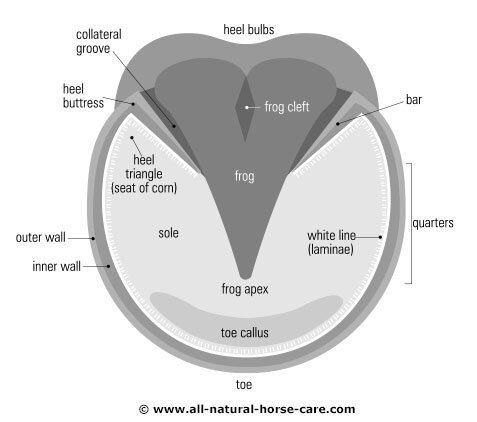Getting In Touch With The Sole Of The Horse
No, I didn’t mean soul!
Today we’re talking about the horse’s sole. The extremely important material covering the bottoms of his feet.
The sole protects the sensitive internal structures of the hoof from the outside world. A horse with a thick sole will travel across rocky surfaces with ease, while a horse with a thin sole will often move comfortably on soft surfaces and then pick his way carefully across stony paths.
A horse should have approximately 3/4” thick soles to move comfortably across most terrain without extra protection from shoes or hoof boots.
Okay, thanks Barb but I don’t have x-ray vision!
Not to worry - neither do I! Thankfully there is a neat trick we can use to estimate sole depth with pretty good accuracy.
The first thing you need to do is identify the collateral grooves. These are the channels on either side of the frog that you pick dirt and poop out of before you ride. By measuring from the bottom of the collateral groove vertically to the height of the sole-hoof wall junction, we can estimate the depth of the sole.
I find this is easiest to do by laying a straight edge across the bottom of the foot (like a rasp or a ruler), and then using the tip of my hoof pick to measure from the bottom of the groove to my straight edge.
You’ll want to measure this depth at the back of the frog near the heel bulbs, and also at the apex of the frog. We should ideally have 3/4” depth in both places!
Often when farriers are trimming the foot to prepare it for shoeing, they trim away sole from the entire bottom of the foot. If I can convince you of ONE THING it is PLEASE DO NOT TRIM SOLE regularly! There are some times when a horse can have excess sole, but these tend to be the exception and not the rule. If you are trimming sole away every time or if you are trimming sole when there is less than a 3/4” depth of the collateral grooves, then you are doing your horse a disservice.
If you trim the sole away until you hit blood, you are getting dangerously close to exposing the coffin bone to the outside world.
There are times when a hoof capsule looks really long, and the first instinct is to cut it back to make a more normal looking hoof. If the collateral grooves are less than 3/4” deep, the hoof is not long because of excess sole material. Instead, you are likely dealing with a hoof that is long because the coronet band is displaced upwards. This is called an increased “CE” or coronet to extensor process measurement, and is something I will get into in a future post!
If you’d like to learn more about the horse’s sole and get into some more technical details, I highly recommend Pete Ramey’s articles. I have linked his article on sole depth below for anyone who is interested!
If you go out to the barn this afternoon and measure your horse’s sole depth and find out it’s less than 3/4” deep - take note, but don’t panic!
You can help your horse build sole depth by making sure your farrier is not cutting sole away during trims and by adding protection with products like Hoof Armor (I have no financial interest in Hoof Armor, it’s just a really neat product). You can protect thin soles from bruising and encourage the movement needed to stimulate sole growth by using hoof boots or composite (not metal) shoes and adding pads if needed. Correct nutrition is also key for growing strong hooves, so double checking what your horse is eating can make a big difference, too.
More on all of this to come! If you have questions in the meantime - please send them my way!
If you like reading my blog posts and would like them delivered to your inbox every week, please sign up for my FREE email newsletter by entering your information below!


